What’s that little pickle hanging on my avocado tree? That’s not a pickle; that’s a cuke: an avocado fruit that developed without a seed inside.
It’s growing on a type of avocado tree called Ettinger, and here is what a normal Ettinger avocado looks like:
The cuke and the normal fruit above are growing on the same tree in my yard. That Ettinger tree is growing near a Fuerte tree, which is another type that often makes cukes. Certain varieties make cukes far more often than others. Ettinger and Fuerte are well known as cuke makers.
In contrast, I’ve never seen a cuke on many other varieties, including Hass. I know that Hass can cuke because I’ve seen photographic evidence, but it’s rare.
(See a Hass cuke in “Avocado Fruit Abnormalities and Defects Revisited” by R. Hofshi and M.L. Arpaia.)
What causes avocado trees to make cukes?
It is not well understood exactly what causes some avocados to develop without seeds and some varieties to make cukes far more often than others. The main cause seems to be a defect in the ovule of the flower that turns into the cuke.
In short, what usually happens in the formation of a cuke is that an avocado flower is pollinated and the ovule is fertilized . . .
. . . and a fruit begins to form. But soon thereafter, the ovule that is meant to become the seed inside the fruit begins to degenerate. The avocado fruit continues to grow despite the tiny seed inside having died off. In the end, the remains of the deteriorated nascent seed are usually almost invisible such that the cuke avocado looks totally seedless when you cut it open — except for a narrow sheath of an empty seed coat in the middle.
(Read more about the process of cuke development in “Seedless fruit in ‘Fuerte’ and ‘Ettinger’ avocado” by E. Tomer, S. Gazit, and D. Eisenstein.)
(See also this technical paper: “An anatomical study of ovary-to-cuke development in consistently low-producing trees of the ‘Fuerte’ avocado with special reference to seed abortion” by E. Steyn, P. Robbertse, and D. Smith.)
Other causes of avocado cukes have been suggested in the past, especially factors related to pollination, weather and temperature during bloom, but these have little explanatory power to me. If “incomplete pollination,” “sudden changes in weather,” or “temperatures that are too low” (three suggested causes) were so consequential, then what explains these two situations?
1. In “Seedless fruit in ‘Fuerte’ and ‘Ettinger’ avocado,” the authors mention “2 trees known to bear mostly seedless fruits (one ‘Ettinger’ tree at Kibbutz Rosh Haniqura and a ‘Fuerte’ tree at the Agricultural Research Organization orchard in Bet Dagan).” In other words, there are groves with many Ettinger and Fuerte trees that make mostly regular avocados, but two trees that make mostly cukes. Surely, the weather and temperatures are nearly the same throughout each grove so how could that be of much influence?
2. One of my childhood friends grew up in a house built within an old Fuerte grove. There were Fuerte trees that produced well all over, but a few years ago I noticed one tree that had lots of cukes and only cukes. I asked my friend about the tree. “That tree never produced a regular avocado in my whole life,” he said. Have bees just ignored this tree and only this tree for decades?
Physical defect in the flowers of certain trees and especially the flowers of certain trees of certain varieties seem to me to be the main cause of cukes — not pollination, weather, or temperature.
Can you eat cukes?
Cukes may be borne from defect, but they taste just as good as any seeded avocado. They are sometimes called “cocktail” avocados. A Fuerte cuke will taste just as good as its bigger brethren.
When to pick cukes?
Likewise, cukes of any given variety will be mature and ready for harvest at the same time as regular fruit. With Fuerte as an example again (since Fuerte is our most common cuke maker in California), if the regular fruit is ready to pick from about December through April, then you can pick cukes from a Fuerte tree during the same period. Cukes also take approximately the same amount of time to ripen on a kitchen counter.
A super cuker in San Jose
I would personally prefer an avocado tree that made an abundance of regular, seeded fruit, but if you loved cukes you would love to have this tree in your yard.
Let’s call it the San Jose Super Cuker. A friend who lives near the tree showed it to me. I had never seen an avocado tree so laden with cukes.
Can you spot the clusters of cukes hanging throughout the canopy? Here’s one close up.
For some minutes we peered through the canopy and only saw cukes, until we eventually spotted a couple regular fruit hiding near the top of the large tree. Hundreds of cukes, a couple of regular avocados. The fruit nor the foliage looked like Fuerte or Ettinger. My guess is that the tree is a seedling, but a seedling with fine tasting little pickles.
In this video, I eat some:
All of my Yard Posts are HERE

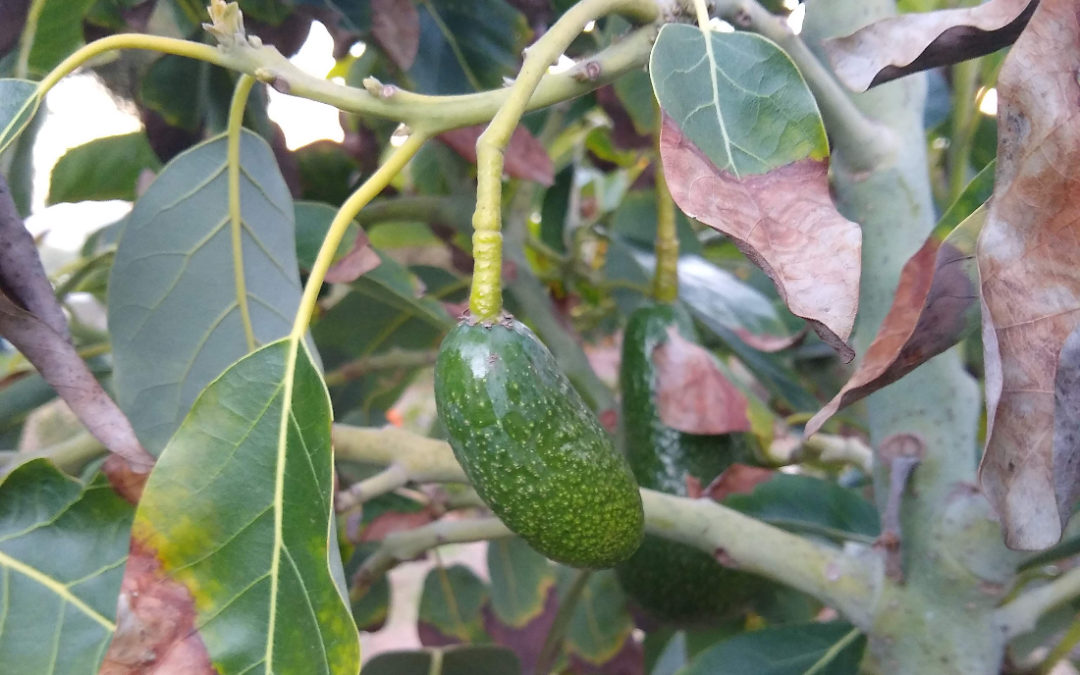
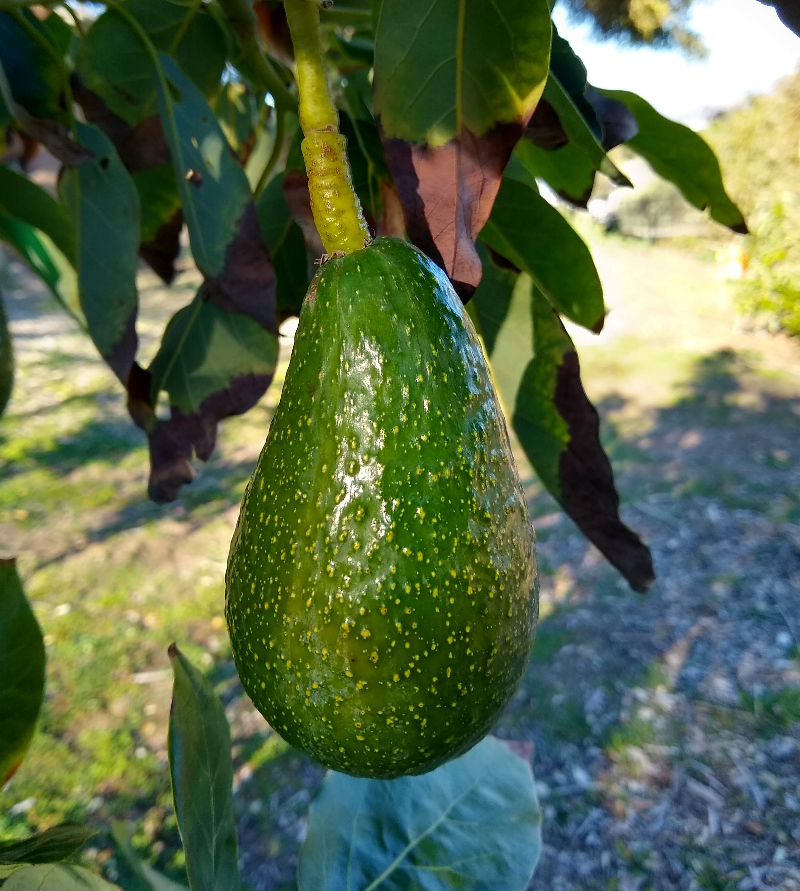
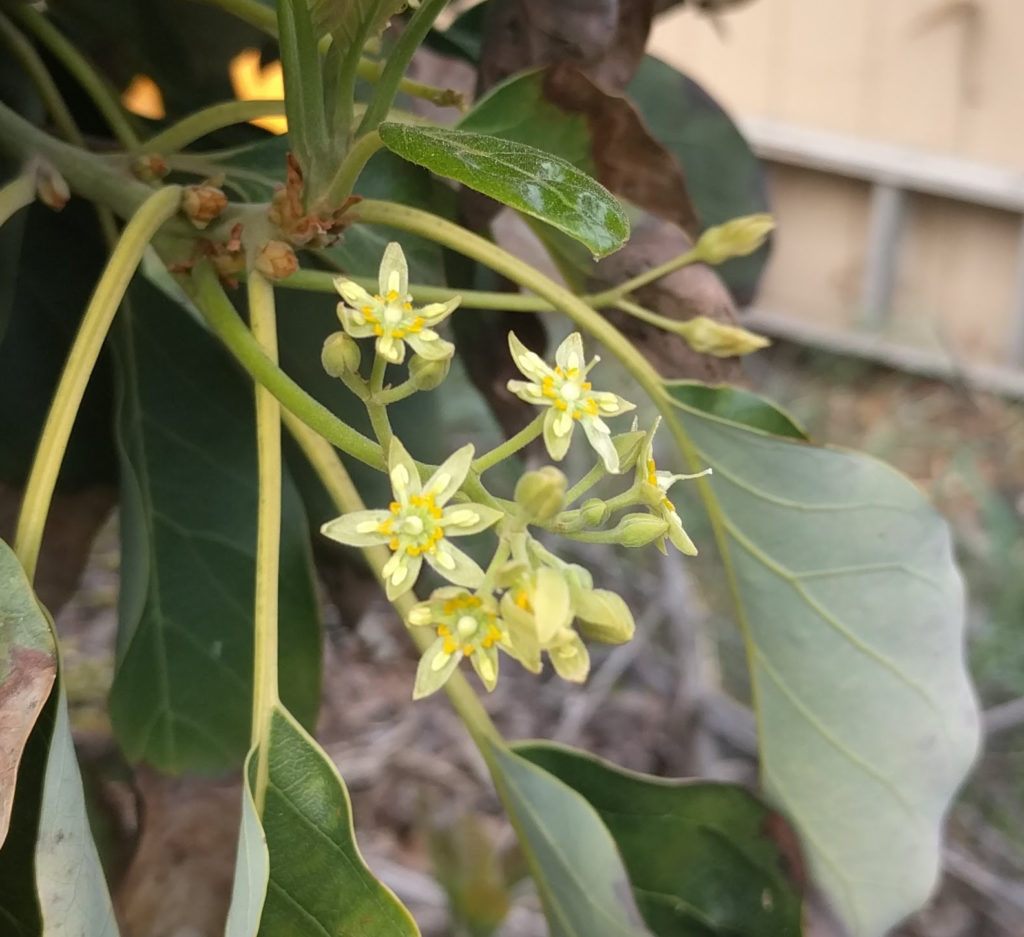

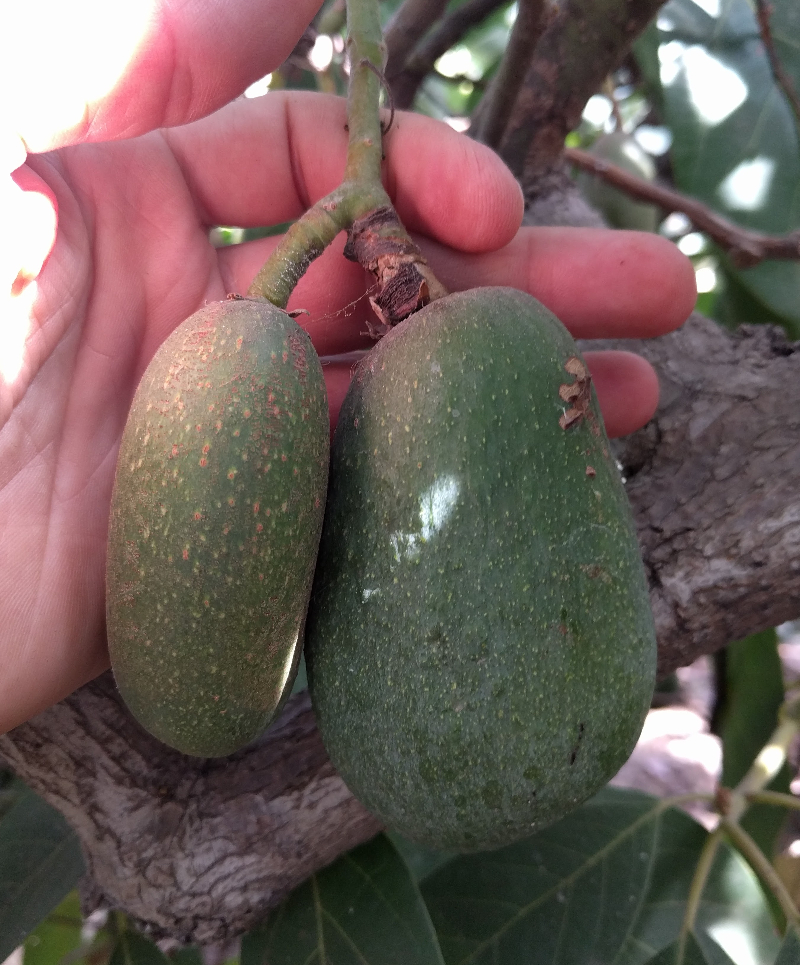
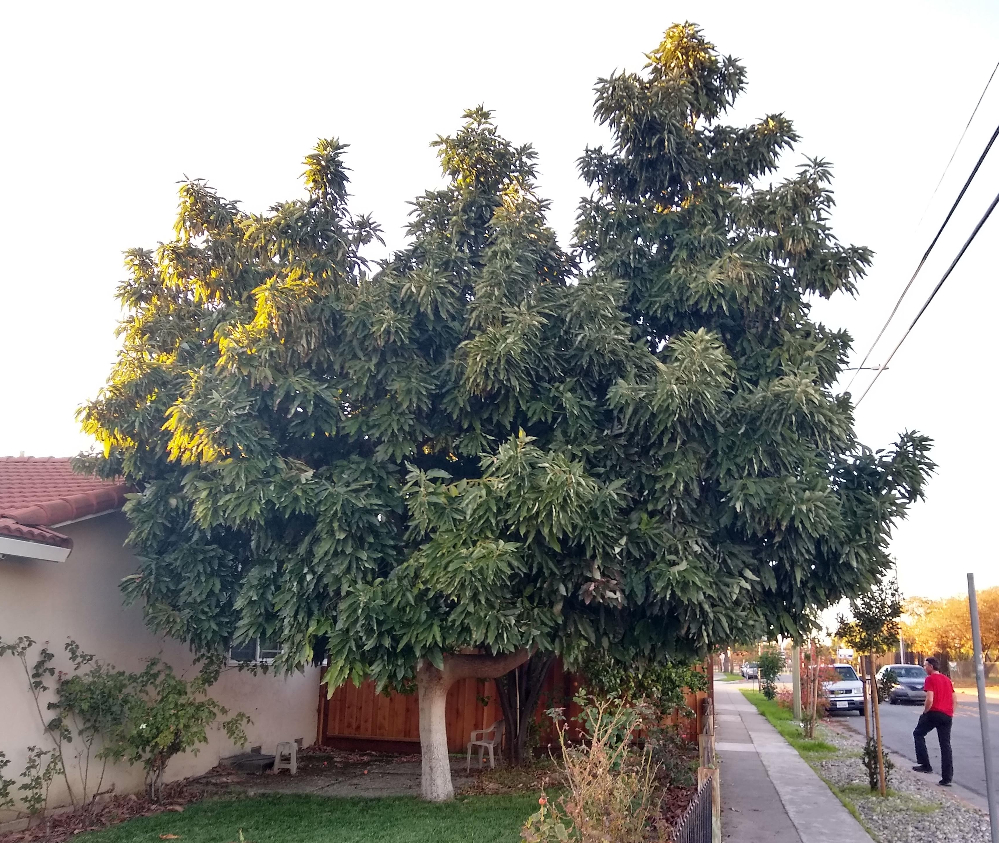
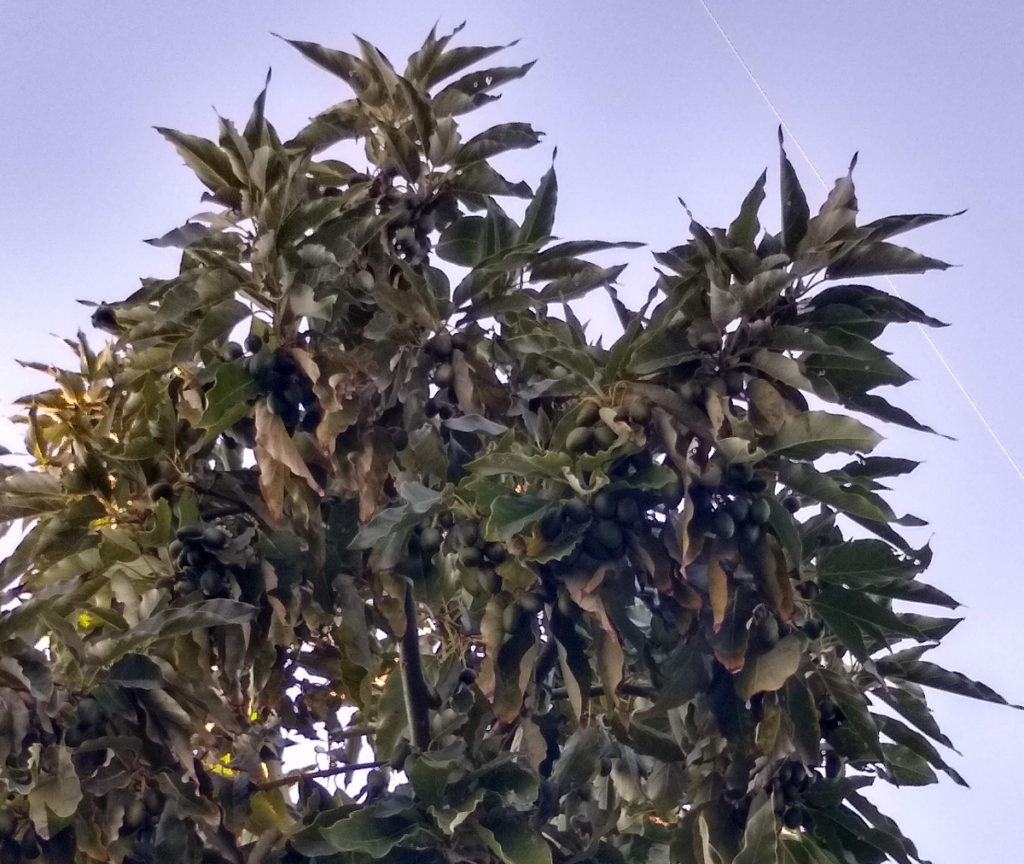



Do you think if someone grafted a scion from the super cuker in San Jose, the new tree would produce the same quantity of cukes? Were you able to taste any to see if they are a good-tasting avocado variety?
Hi Neal,
My guess is that a graft from that tree would similarly produce lots of cukes, but that’s just a guess. I tasted only the cukes — no regular fruit — and they were good.
Hi Greg,
I’d love to try and graft this onto a few trees and see if I can get cukes. There maybe a market for them via charcuterie boards and just as a novelty. Any way your friend in San Jose or the other cuke fuerte grower might send some cuttings to me or let me come take some? I’d pay for them. I’m in Ventura county.
Cory, did you ever get more info on this? I’d love to try doing the same thing.
Finally, an explanation of this tree in my backyard. It started knee-high years ago and now years later is taller than the telephone pole. Every morning, fruit drops and I pick them up before squirrels nibble on them. For years, there was no fruit, but five years ago normal size avocados grew, since then only cukes or what I call baby avocados. I live in Sunnyvale close to San Jose.
Perfect timing on this post. We have one tree in our grove of Hass that has a fierce branch. I found my first clue the other day. Had heard of them but didn’t know the name. Looking forward to enjoying it soon!
Hi Keely,
Did autocorrect play with your words? Is it a Fuerte branch on one of your Hass trees? And you found your first cuke, not clue, right? Cool!
Laughing. As soon as I hit send I saw that. Yes. It is indeed a fierce Fuerte branch on our Hass tree and I have found a cuke AND a clue.
I am looking at “watering avocados in California” listed on 2022 The Yard Posts.
There are three columns, month, how much water and how often?
According to the table, gallons per day for a 10 feet canopy diameter is 3 in Jan, and water every 14 days. My question is, do I water every day with 3 gallons of water? Or do I water with 42 gallons of water on the 14th day? I am confused, please help.
Hi John,
Usually, it’s best to follow the frequency listed for the month, so that would mean watering about 40 gallons every two weeks for your tree here in January. Only if there’s a lot of Santa Anas for a while would your tree need water more often this time of year, probably — you still have to get to know your soil and location.
As a reference, I have not watered any of my avocado trees since we got that great series of rains near Christmas.
Hello,
After mich research I realize we have what is called an heirloom avocado tree. We grew it from a pit and have had for a couple of years now. I e also learned that if I want it to ever fruit I will have to graft it, do you happen to have any recommendations on how I can graft it or know anyone that can without damaging it. It is currectly posted and is about 4ft tall. I see constant new growth in leaves but no flowers:(
Hi Angie,
What makes you think your tree won’t fruit unless you graft it? Almost all seedling avocado trees eventually produce fruit; it’s just that they usually take longer to fruit than grafted trees. You might find this post useful: https://gregalder.com/yardposts/what-kind-of-avocado-tree-do-you-get-when-you-plant-a-seed/
Hello Greg hope this finds you well. In the very first picture, that of a cuke, what is the cause of the leaf browning?
Hi Faruk,
Here’s my post about why avocado leaves turn brown (like the leaves in the picture with the cuke): https://gregalder.com/yardposts/avocado-leaves-turning-brown-why/
Hello Greg Many thanks for taking the time to answer my query.
Whilst this may not be suitable for a yard tree, it may be worth the investment for someone with a few more trees. Look up Alvatech technology – changes irrigation properyies to allow udage of water with ec of 2.2 dS/m without any problem. The water usef to irrigate also moves out bicarbonates, chlorides, Sodium, Boronnout of the root zone. If yiu have difficulty getting hold of this info please let me know.
…..thanks again
Hi Greg, I‘m actually going to be in San Jose next week and I would love to try and graft some of these scions to see what happens. Any chance you or your friend can point me in the right direction? Thank you